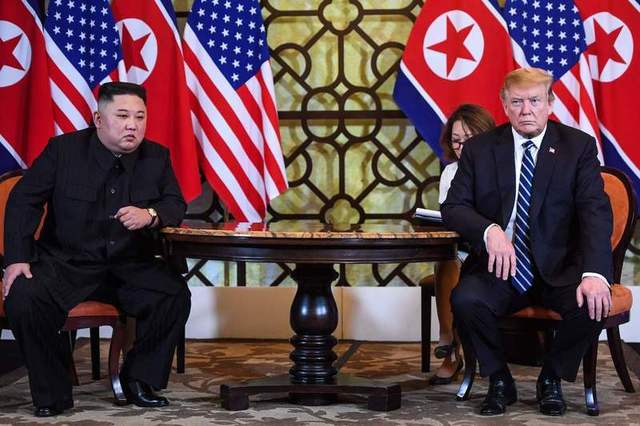Posted on : Mar.11,2019 16:57 KST
Modified on : Mar.11,2019 17:15 KST
 |
|
North Korean leader Kim Jong-un and US President Donald Trump at the Sofitel Legend Metropole Hanoi hotel on Feb. 28.
|
Following the breakdown of their summit in Hanoi, North Korea and the US have been sending each other contradictory messages – some aggressive, others gracious. Our concern is that these confusing attitudes could cause the situation to deteriorate and ultimately torpedo the negotiations. This is a time for both North Korea and the US to exercise restraint and make an effort to preserve the momentum for dialogue.
When the remarks by the leaders of North Korea and the US are considered by themselves, it seems clear they have no intention of ruining the framework of dialogue. North Korean leader Kim Jong-un recently said that no mission is more urgent than economic development and the public livelihood. The fact that Kim emphasized the economy in his first remarks after the Hanoi summit can be taken as indicating that he doesn’t intend to aggravate the situation. And on Mar. 8, US President Donald Trump showed his determination to continue dialogue by emphasizing his positive relationship with both North Korea and Kim.
But at the same time, dangerous signals continue to appear. The first signal that requires our attention is the developments at North Korea’s launch site at Tongchang Village. US media has reported that this launch site has been restored and that there are indications that North Korea is preparing to launch a missile or satellite-carrying rocket in a short time.
For now, to be sure, there are few grounds to regard ordinary operations at the launch site as being a predictor of direct action. But in the event that North Korea takes action because of increasing conflict, the situation is likely to spiral out of control. Even a satellite launch by North Korea would obviously rattle the North Korea-US relationship because such a launch would involve intercontinental ballistic missile (ICBM) technology. North Korea needs to exercise more restraint than ever before, and the US should also not provoke the North.
The US demands for an all-in-one deal are just as counterproductive, since they narrow the potential for negotiations. A high-ranking official in the US government recently called for an all-in-one deal for dismantling all of North Korea’s programs involving weapons of mass destruction and said that no one in the US government advocates a step-by-step approach.
These remarks can be seen as a retreat from the principle of step-by-step and simultaneous action that was elaborated by US State Department Special Representative for North Korea Stephen Biegun before the Hanoi summit. If the US keeps pushing for an all-in-one deal while the North insists on a step-by-step approach, it’s bound to obscure prospects for negotiations. Our concern is that such an all-or-nothing approach will ruin everything.
We haven’t yet reached the point where it’s clear which direction North Korea-US relations will take. The US State Department said on Mar. 7 that the door for dialogue with North Korea remains open. During a conversation with South Korean President Moon Jae-in shortly after the abrupt end of the Hanoi summit, Trump reportedly asked Moon no fewer than seven times to serve as a mediator between North Korea and the US.
But if North Korea and the US continue to take action that narrows the possibility of negotiations as they’re doing right now, the door for dialogue itself could slam shut. The South Korean government needs to focus its mediating efforts on finding a way for North Korea and the US to use restraint and resume dialogue with each other. If a solution could be found for inter-Korean cooperation – including the resumption of operations at the Kaesong Industrial Complex and tourism to Mt. Kumgang, in which North Korea has taken an interest – it could create a good opportunity to turn the situation around.
Please direct comments or questions to [english@hani.co.kr]






